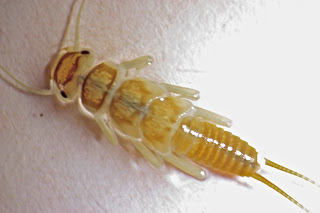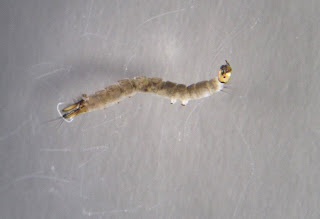There is a limit to the types of insects I'm going to find while I'm writing this Blog. What I discover will almost always be based on trips I'm making to streams on my own, and I'll be looking for insects by lifting rocks and sifting through leaf packs. That means that I will rarely see insects that spend most of their time in the substrate and/or chewing away on sunken limbs and logs. So there will be only occasional mention of "beetles" (with the possible exception of Water Pennies and Whirligig Beetles -- on which, more below.) But let me say a few words about them in this entry since they are important members of the ecological communities in our streams.
Without any question, the beetle family we see most often is the Elmidae family -- Riffle Beetles.
We see the adults (fully aquatic) and the larvae. Pictured above is a Riffle Beetle adult -- but remember, this is a highly magnified image. In reality, Riffle Beetle adults are rarely bigger than a grain of pearled barley and can be the size of a grain of couscous (i.e., they're barely visible on the net). A distinctive feature of this beetle is the antennae: they are long, and often reddish in color. These can usually be seen with a loupe. Riffle Beetle larvae are commonly referred to as "comma bugs," and the photo below shows us why. When put into a sampling tray, they often curl up in this fashion.
We find Riffle Beetles, both adults and larvae, in almost all of our streams, but they are more numerous in some rather than others, this is especially true of some of the streams in the southeastern part of our watershed (Fluvanna County: Raccoon Creek, Ballingers Creek, Long Island Creek). I don't know why this is the case. Perhaps someone else can explain it. (Comments are welcomed.)
Many (most?) of the samples done by StreamWatch this fall were dominated by Riffle Beetles. We have a strong suspicion that this is related to the bad drought conditions we had most of the summer.
By September, if not before, a lot of our streams had simply dried up and stopped running. Mayfly, stonefly, and caddisfly nymphs were very scarce in our initial fall samples (did they die off? or did they save themselves by digging deeper into the substrate?). But Riffle Beetles -- and some of the other beetles as well -- seemed to survive the drought very well.
The Dryopid (Long-toed) Beetle is close in appearance to the Riffle Beetle adult, and the two can be confused by samplers. But Dryopid beetles are always larger than Elmid beetles, and they have only short, stubby antennae (visible in the photo above). In the photo below, I've placed the two side-by-side -- Riffle Beetle on the left, Dryopid beetle on the right -- so the reader can get a sense of comparative size. But remember, this is still a "microscope" picture.
After Riffle Beetles, the second most common beetles we see are Water Pennies (family: Psephenidae).
The name seems fitting given their shape and color. In the photos below, upper left is the dorsal side of the beetle; lower right is the ventral.
Water Pennies may get as big as a pea (though they're flat), but they are often the size of tiny brown dots on the net. Water Pennies are "scrapers" when it comes to their mode of eating. Thus, they are always clinging to rocks, moving slowly over the rock surface, grazing algae and periphyton as they go. They too survived the drought well.
There are four more beetle families that we see in our streams, but it is rare that we see them. One is the "Toe-winged" Beetle (Ptilodactylidae) -- which can be mistaken for a very large "comma bug." In the photo below, with the "comma bug" placed at the top, we can get a sense of their relative size.
Only two-thirds of the Toe-winged beetle is showing. Toe-winged beetles can be as long as 3/4"; comma bugs are rarely more than 1/4" long. Also, although this picture does not represent this, the Toe-winged beetle is often a yellow/orange color. We have found these, in very small numbers, in only a few of our streams.
Water Scavenger beetles (Hydrophilidae) are somewhat more numerous, but found mostly in large rivers -- like the main stem of the Rivanna. There are two types of Water Scavenger beetles, and as the pictures below reveal, they are quite different in appearance.
The Whirligig Beetle (Gyrinidae) is one I've seen in only two streams: Buck Mt. Creek and Mechunk Creek. In both cases, I've found them in the summer (this is the larval form of a terrestrial insect), and they prefer to live in the matted vegetation that grows on some of the rocks. They move quickly, and you have to be adept with the tweezers to grab them.
Finally, rounding out the list of beetles we find in our streams is one that we hardly ever see, the Predaceous Diving Beetle (Dytiscidae). I've found only one (this one) in my explorations. That was last fall in a small stream that runs along Reservoir Road (coming down from the Ragged Mt. Reservoir). These are predators -- as are Water Scavenger beetles and Whirligig Beetles -- and they've been known to go after small fish!

















































